An Ancient Yule, a Comet in the Camel Leopard, the Sun Surrounds the New Moon, and a Flight through Pegasus!
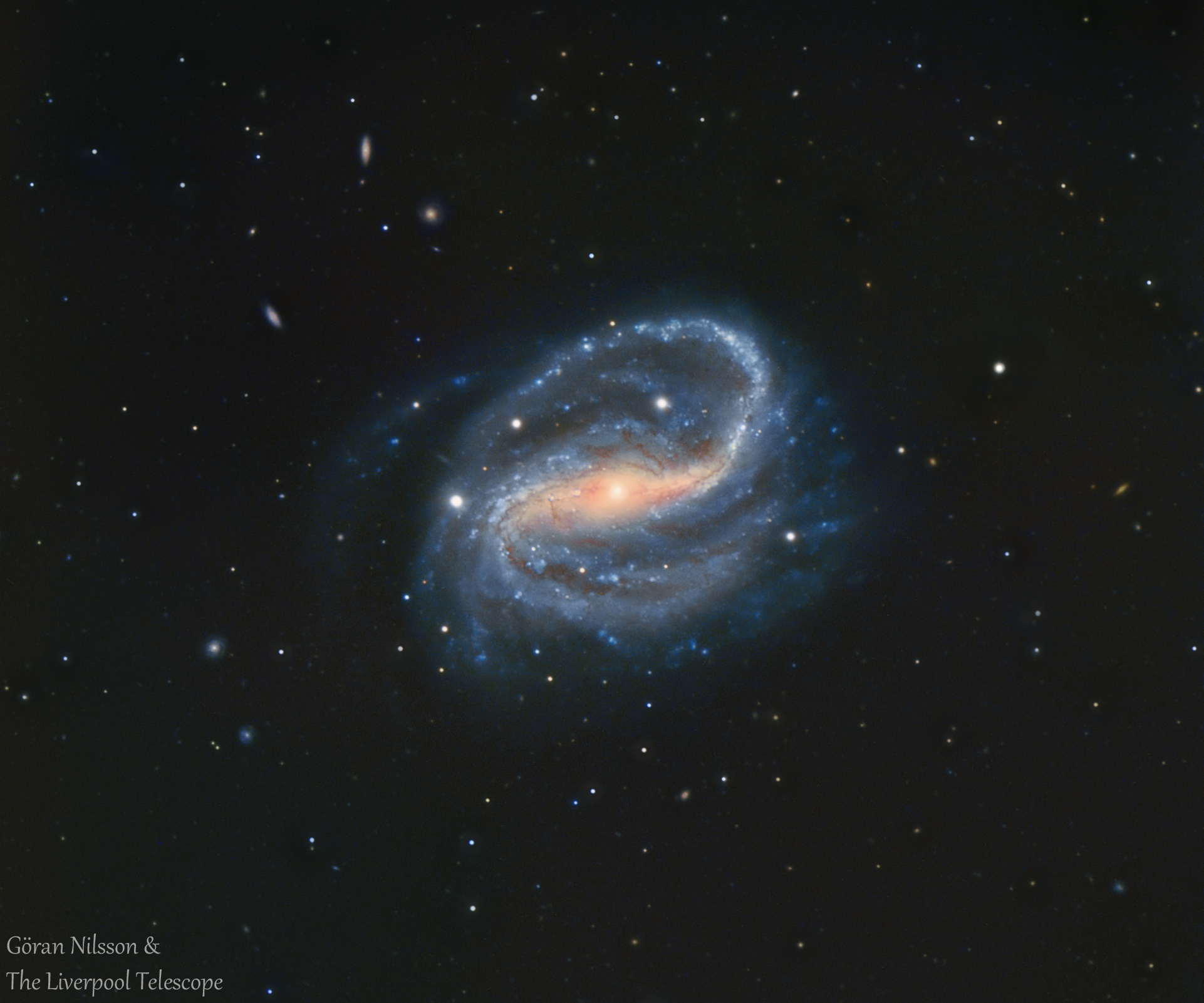
This image of the beautiful Superman Galaxy, more formally known as NGC7479 and Caldwell 44, was captured by Goran Nilsson using the 2-metre Liverpool Telescope on the Canary Islands. The galaxy is 105 million light-years away from the sun, in the constellation of Pegasus. It’s also considered by astronomers to be “peculiar”.
Hello, December Stargazers!
Here are your Astronomy Skylights for the week of December 22th, 2019 by Chris Vaughan. Feel free to pass this along to your friends and send me your comments, questions, and suggested topics. I repost these emails with photos at http://astrogeo.ca/skylights/ where all the old editions will be archived. You can also follow me on Twitter as @astrogeoguy! Unless otherwise noted, all times are Eastern Time. To subscribe to these emails please click this MailChimp link.
I can bring my Digital Starlab portable inflatable planetarium to your school or other daytime or evening event. Contact me through AstroGeo.ca, and we’ll tour the Universe together!
For those who have been reading my Skylights on Tumblr, I have migrated the content to my website, where I can better control the size of the photos and sky charts. The page where the Skylights are listed is located at http://astrogeo.ca/skylights/. We’re still perfecting the site, so let me know if you have any comments or suggestions.
The moon passes the sun so closely this week that it triggers an annular solar eclipse. The new moon won’t return to evening skies worldwide until the end of the week – leaving them nice and dark for leftover Ursids meteors, for comet hunting, and for viewing the delights of Pegasus. After sunset, lovely Venus will climb the western sky as dimmer Saturn disappears. Meanwhile Mars will shine below some bright stars in the pre-dawn east. Here are your Skylights! And here’s wishing you all a Holiday period filled with love, peace, happiness, family, fun, and clear skies!
The Moon and Planets
The moon will spend this week completing the final stages of its monthly orbit of Earth and then re-appearing in the western post-sunset sky by week’s end.
Tomorrow morning (Monday), the very slim, old crescent moon will rise at about 5 am local time. It will shine prettily in the east-southeastern sky, positioned a slim palm’s width to the lower left (or 6° to the celestial northeast) of Mars. The duo will dance until brightening sky overwhelms Mars – leaving the moon to linger into the daytime morning sky. On Tuesday morning, the even slimmer moon will have descended into the pre-dawn twilight – and on Wednesday morning, it will be too close to the sun for viewing.
New moon will officially occur at 12:13 am EST (or 05:13 GMT) on Thursday, December 26. When at its new phase, the moon is positioned in space between Earth and the sun. Since sunlight can only reach the side of the moon facing away from Earth, our natural satellite becomes completely hidden from view for a day or two.
This new moon will occur while the moon is close to its descending node (the location in the sky where the moon’s and the Earth’s orbits cross one another). The moon will also be approaching apogee (the moon’s farthest distance from Earth) – setting up an annular solar eclipse. The track for the eclipse will commence near Riyadh, Saudi Arabia, where it will be or 154 km wide. The eclipse will then sweep southeast across southern India near Kannar (narrowing to 129 km), cross through Malaysia, the southern Philippines, and Guam, and end in the North Pacific.
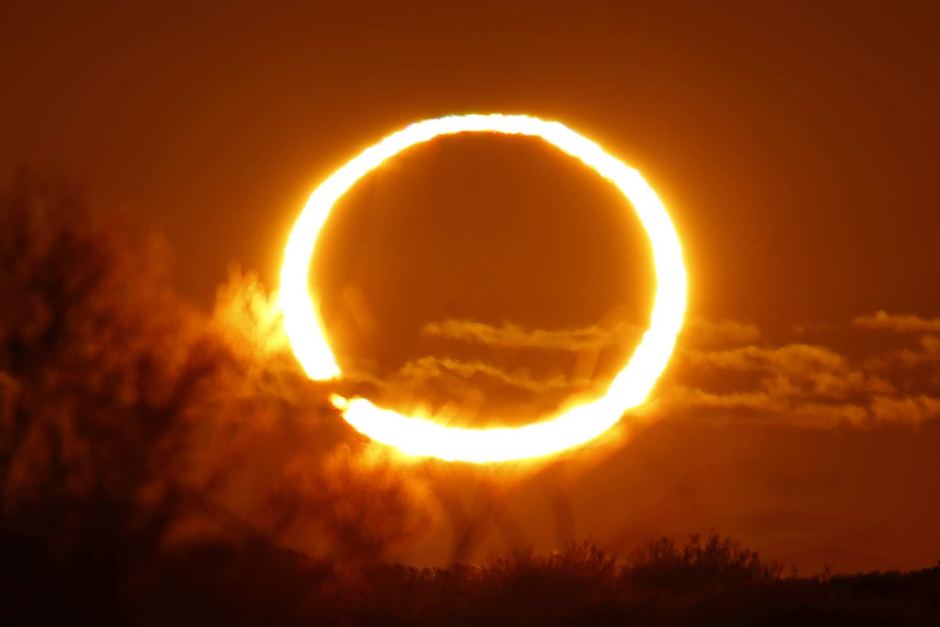
The accompanying partial eclipse will be visible over a broad region covering southern Russia, across Asia to northeastern Africa, and northern Australia. Maximum eclipse, when 94.11% of the sun’s disk will be covered, will occur for 3 minutes and 39.9 seconds southwest of Singapore starting at 05:24 GMT. Proper solar filters will be required to view any portion of this eclipse in person. None of the eclipse will be visible from the Americas – but several organizations will live stream it on YouTube.
The moon will return the western evening sky on Thursday night, but it won’t really be visible until after sunset on Friday, when its slim silver crescent will shine above the southwestern horizon. That same evening, the moon will be positioned a palm’s width to the upper left of Saturn. The duo will make a nice sight in binoculars – but don’t use them until the sun has completely disappeared from view.
In the southwestern sky after sunset on Saturday, the crescent moon will occupy a position about three finger widths below Venus, making another lovely scene for binoculars or a widefield photograph. (Try resting your smartphone on something steady and use the delayed shutter option to take a picture!) Observers in Antarctica and the southern tip of South America will witness the moon pass in front of (or occult) Venus.
Speaking of Venus, our brilliant sister planet will continue its lengthy winter appearance this week – shining very brightly in the southwestern evening sky, starting in twilight and setting after 7 pm local time in a darkened sky. While aircraft in that part of the sky might appear as bright as the planet, Venus will be distinguishable by its steady, unwavering light. Viewing Venus in your telescope during the upcoming weeks will reveal that its already less-than-fully-illuminated disk is waning as it swings wider from the sun. Try for telescope views of the planet while it is higher in the sky at around 5 pm local time – after the sun has completely set.
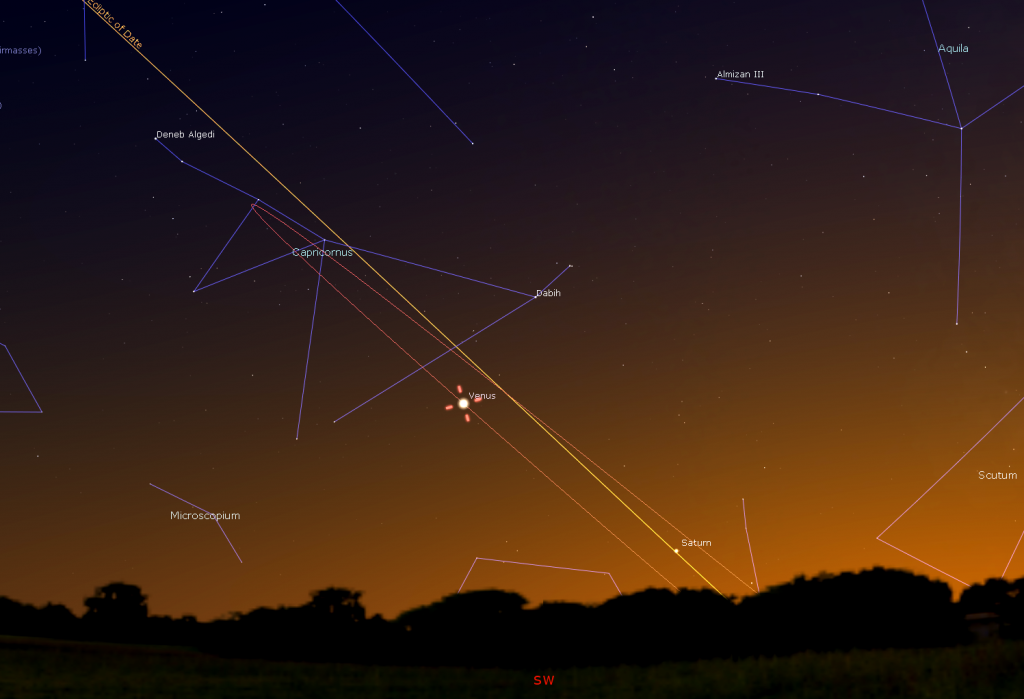
For the first part of this week, you can use bright Venus to locate much dimmer Saturn for short time after sunset. The ringed planet is being carried towards the sun by Earth’s motion while Venus rapidly moves in the opposite direction. Tonight (Sunday) Saturn will be located 1.3 fist diameters to the lower right of Venus (or 13° to the celestial west of Venus). By next Sunday evening, Saturn will be all but gone into the twilight.
Because the planets change position over time, and each one moves at a different rate, the planets one can see in a given season varies year-by-year. This winter, the only easy planet to see during the evening will be Venus. Mercury will briefly make a nice evening appearance in February. In the meantime, while we wait for next spring’s return of Mars, Jupiter, and Saturn, evening planet-watchers will have to settle for the ice giant planets Uranus and Neptune. Despite their relatively dim magnitudes and small disk sizes, the delightful colours of those two remote planets make them worthy of a look in backyard telescopes – although they can be tricky to find.
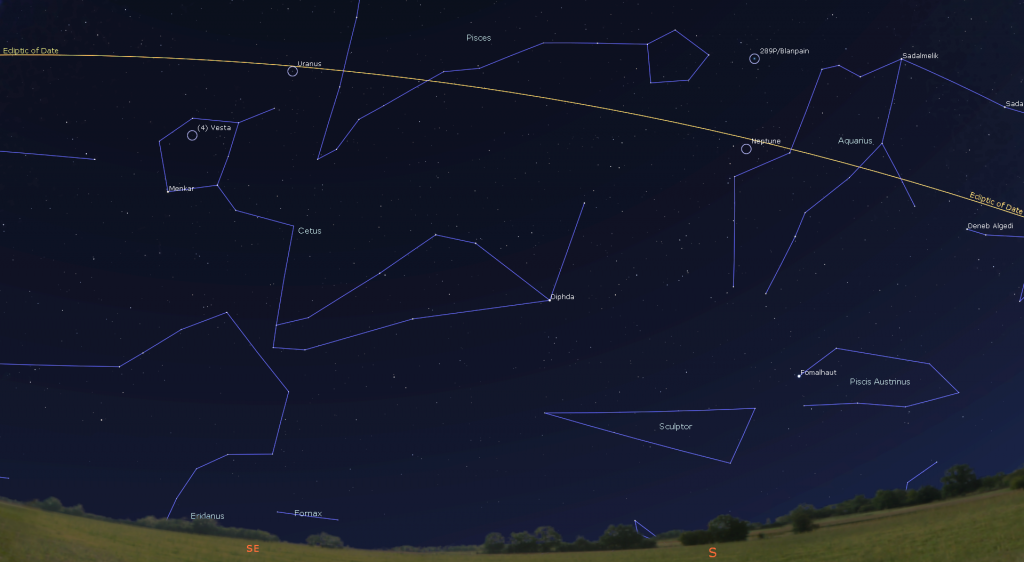
Blue-green Uranus is observable from dusk until the wee hours of the night. It is located a generous palm’s width to the left (or 7° to the celestial east) of the modest stars that form the “V” of Pisces (the Fishes). Uranus is also below (or to the celestial south of) the medium-bright stars of Aries (the Ram), and above the ring of stars that form the head of Cetus (the Sea-Monster).
Shining at magnitude 5.7, Uranus is bright enough to see under dark sky conditions with unaided eyes and with binoculars – or through small telescopes under less-dark conditions. To help you find it, I posted a detailed star chart here. If you view Uranus at about 8 pm local time, it will be highest in the southern sky – and you’ll be looking through the least amount of Earth’s disturbing atmosphere.
Distant and dim, blue Neptune will set before 11 pm local time this week, so you should try to observe it as soon as the sky is dark, when Neptune is higher – a little less than halfway up the south-southwestern sky. Slow-moving Neptune is situated among the stars of eastern Aquarius (the Water-Bearer), and is positioned a thumb’s width to the right (or 1.5 degrees to the celestial west) of a medium-bright star named Phi (φ) Aquarii. Both blue Neptune and that golden-coloured star will appear together in the field of view of a backyard telescope at low power. While the bright moon is out of the night sky this week, magnitude 7.9 Neptune will be visible in binoculars. Find Phi Aquarii first and then locate nearby Neptune. Remember that binoculars will display the true positions of the objects, but your telescope will flip and/or mirror-image the view. (To find out what your telescope does to the image, see how it changes the view of the moon, and make a note of the result.)

Red-tinted Mars is climbing the eastern pre-dawn sky, where it will rise at about 4:40 am local time and remain visible until dawn. The medium-bright stars sitting above Mars are named Zubeneschamali and Zubenelgenubi. They represent part of the balance scale mechanism of Libra. Long ago, those stars represented the claws of Scorpius (the Scorpion), which rises later. Zubenelgenubi is an easy-to-see double star.
From now until October, 2020, Mars will continually grow in brightness – and will increase in apparent size when viewed in telescopes. In fact, the 2020 Mars opposition is a terrific reason to get a telescope now, so you can practice viewing the planet during the spring and summer months of 2020 – especially when the moon, Mars, Jupiter, and Saturn all meet up next March 18! If you missed my recent note about buying a beginner telescope, I posted it here.
A Christmas Star?
Seeing Venus every evening nowadays, it’s easy to imagine that sky-watchers of old could be captivated by Venus’ brilliance and name it a “Christmas Star”. But Venus puts on these celestial showings every two or three years – hardly a rare occurrence. The event that may have spawned the biblical story of wise men following a star in the east, was a planetary conjunction of Venus, Jupiter, Mars, and Venus that occurred in the pre-dawn sky in November of the year 1 CE. In fact, on one of those mornings, Venus and Jupiter were so close together that they might have looked like a single, extra-bright object!

All four bright planets were grouped into a stubby line that spanned less than four fingers widths in length. Head outside on the next clear night, hold up your hand beside Venus, and imagine how impressive those other planets gathered around her would have looked.
Coincidentally, at that time Mars was where it is in the sky this week – nestled within the stars of Libra (the Scales)!
Andromeda’s Family – the Wings of Pegasus
Late fall and winter evening skies feature a group of easy-to-see constellation that are the characters in a grand story from Greek mythology – the tale of Princess Andromeda and the hero Perseus. Last week, I told their story here, and described the constellation of Cassiopeia. This week, we’ll look at Pegasus – the westernmost constellation in the set. But let’s flesh out his story a little first…
Before hunting the Gorgon Medusa, Perseus was given some magical gifts to aid him in his quest, including winged silver sandals called the Shoes of Swiftness. Immediately after slaying the snake-haired Medusa by cutting off her head, he flew into the air to avoid Medusa’s angry sisters. While hovering there, some of the gorgon’s blood dripped on the seashore below. Poseidon mixed the blood with the sea foam, and magical Pegasus, whose name is derived from the Greek word for wellspring “pegai”, sprang from the sea.
Pegasus has traditionally been associated with beauty, wisdom, and poetry. In some stories, the majestic wild white stallion was tamed by the warrior Bellerophon, the most successful hero of ancient Greece – until Hercules came along later. After many heroic deeds astride Pegasus, Bellerophon felt that the he was worthy of living in Olympus with the gods, and attempted to ride Pegasus there. But they denied him – sending a bee to sting Pegasus, who bucked and tossed Bellerophon from his saddle. The hero died from the fall to Earth, but he has an interesting role among the stars – as we’ll cover below. Zeus then added Pegasus to his stables, using him to transport thunderbolts. As a reward for his service, at the end of the horse’s days, he was granted a place among the stars.
The constellation Pegasus (the Winged Horse) enters the eastern evening sky in September, becomes well placed for evening astronomy, high in the southern sky during November and December, and then gradually sinks into the western twilight in February. It is one of the largest (seventh by area) and oldest of the 88 modern constellations. The stars of Pegasus only depict the horse’s head, forelegs, and wings rising out of the ocean, while the rest of the animal is occupied by the constellation of Pisces (the Fishes). In Chinese astronomy, the stars of Pegasus make up the Black Tortoise of the North, one of the legendary Four Benevolent Animals in the stars.
Pegasus contains one of the most obvious asterisms in the sky. An asterism is a shape or pattern made up of prominent stars, and it can use some of the stars in a single constellation, or combine stars from adjacent constellations. (The Big Dipper is an example of the former case, since the dipper uses only part of the large constellation Ursa Major.) Pegasus’ asterism is a giant square of four equally bright stars called the Great Square of Pegasus – perhaps a Holiday gift box? But it will probably remind you of a baseball diamond when you see it, because it’s usually tilted with one corner downwards. For the Lakota people, the square represented the great shell of Keya, the Turtle.
Pegasus has traditionally been depicted upside-down, with the square representing his wings, the stars to the west (to the right) forming the head and neck, and two chains of stars at the upper right of the square representing the front legs. To the west (or right) of Pegasus’ head is a tiny and dim constellation of four stars called Equuleus (the Little Horse). Beyond Pegasus’ legs sits the prominent constellation of Cygnus (the Swan), with its bright Summer Triangle star Deneb. Adjoining Pegasus on the eastern (lefthand) side, and sharing a major star with him, is Andromeda (the Princess). The water constellations of Pisces and Aquarius (the Water-Bearer) are below Pegasus.
Let’s tour Pegasus. After it gets dark, face the southern sky. Using unaided eyes only, the Great Square appears empty. You might be able to pick out one or two dim stars inside it – more if you are away from light-polluted skies. The square’s edges are about 16° long (or 1.6 fist widths when held at arm’s length), and about 20° from corner to corner. In mid-December at 6 pm local time, the square’s centre is fairly high in the sky – about two-thirds of the way from horizon to zenith. It’s already highest, in the southern sky, at that time, and then sets in the west by 2 am local time.
The star at the southeast corner (lower left) of the diamond is Algenib, Arabic for “the Side”. It’s a very hot blue-white star of moderate brightness that sits about 350 light-years away from us, and actually emits 4,000 times more light than our sun! Moving counter-clockwise, the white star at the lower right-hand corner is Markab “the Saddle”. This star appears slightly brighter than Algenib – it emits less light, but it is only 140 light-years away.
From Markab, look west for the dimmer stars that trace the horse’s neck and head. A palm’s width from Markab is blue Homam “Man of High Spirit”, then another fist’s width further on sits Biham. Both are about equal in brightness. From Biham look a palm’s width higher to the right for bright star Enif “the Nose”. Enif is a cool orange supergiant star 670 light-years away and is nearing the last stages of its life. You should be able to perceive that its colour is tinted. Enif is huge! Were it to replace our Sun, it would span 40° of Earth’s sky, eighty times wider than the Sun or Moon! Enif is just at the lower mass limit for dying in a supernova explosion. Use binoculars to scan the sky about four fingers widths to the west of Enif. You’ll find a dim, but pretty, little fuzzy patch of stars designated Messier 15. That globular star cluster is 33,000 light-years away from us.
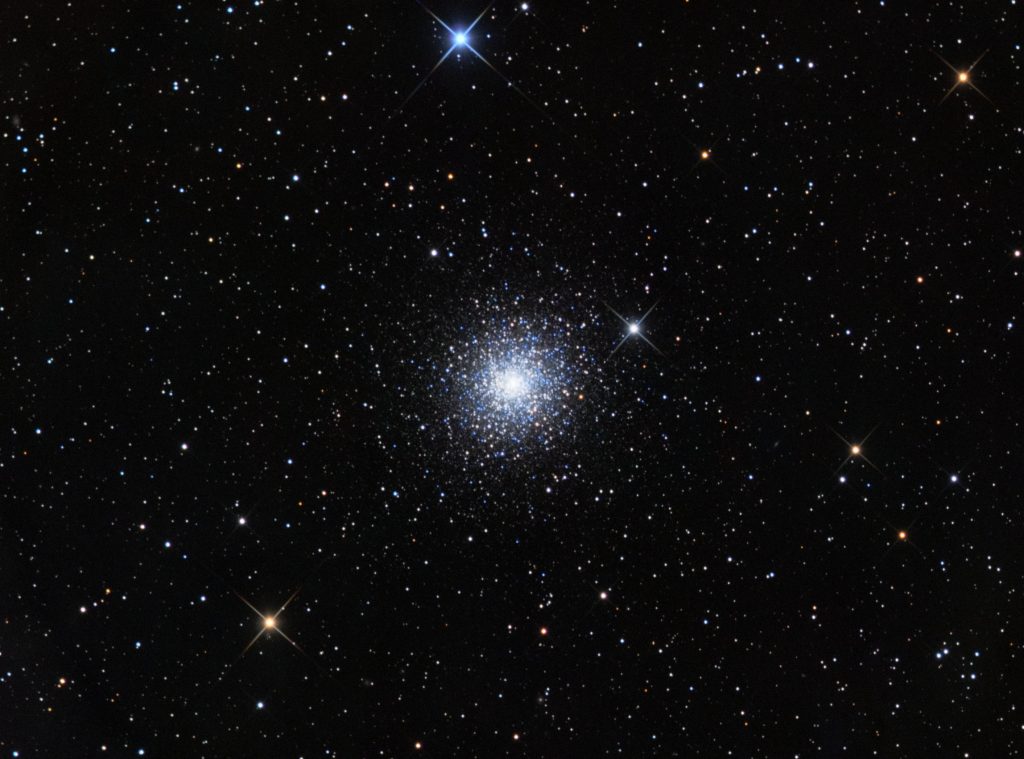
Returning to the square, the fairly bright magnitude 2.4 star at the northwest (upper right) corner is Scheat “the Foreleg”, the second brightest star in the constellation. It’s a cool, red giant star located 200 light-years away from us. Pegasus’ two legs start at Scheat and extend upwards to the right. Five degrees to the right of Scheat is the dim yellow star Matar “Lucky Star of Rain”, and the leg terminates a palm’s width farther in the same direction at a double star designated Pi Pegasi. Using binoculars you should be able to see that Pi consists of two close-together yellow-white stars.
The second foreleg takes a jog to the lower right before bending back up parallel to the first one. A well-spaced pair of yellowish stars named Sadalbari “Luck Star of the Splendid One” and Lambda (λ) Pegasi marks the knee. The foreleg extends to a faint white star a fist’s width to the upper right, and ends at a dim white star an additional 5° away.
A dim yellow star sits a thumb’s width just outside of the baseball diamond, midway between the lower and upper right corners. This is the sunlike star designated 51 Pegasi. It hosts the first exoplanet ever discovered, in 1995! Dubbed Bellerophon, it is a Jupiter-sized planet that orbits the star every 4.23 days at a distance much closer than Mercury does in our solar system. Planets like this are called hot Jupiters. Take a look at the star in your binoculars and let your imagination soar like Bellerophon!
The final star of the square, at the northeastern (upper left) corner, is called Alpheratz “The Horse’s Shoulder”. It’s another hot, blue-white supergiant star, but located only 97 light-years away from us. The spectrum of this star’s light indicates that it is highly enriched in the metal Mercury. In actuality, Alpheratz does not belong to Pegasus. It’s the brightest star in Andromeda, and marks the princess’ head – but that’s a tour for another day!
For Skylights readers with good-sized telescopes, Pegasus is loaded with galaxies! This is because the constellation sits well away from the obscuring material of our Milky Way, allowing us to peer deeper into the Universe. One of my favorite sights is NGC7479, also designated Caldwell 44, an S-shaped spiral galaxy that resembles Superman’s sigil. In fact –the galaxy’s nickname is the Superman Galaxy! I’ll post a picture of it here.
A Binocular Comet
A relatively dim comet will be traversing the northeastern evening sky this winter. Designated C/2017 T2 (PanSTARRS), it is currently at magnitude 8.4. That means that it is conveniently positioned for evening viewing in good binoculars or a backyard telescope.
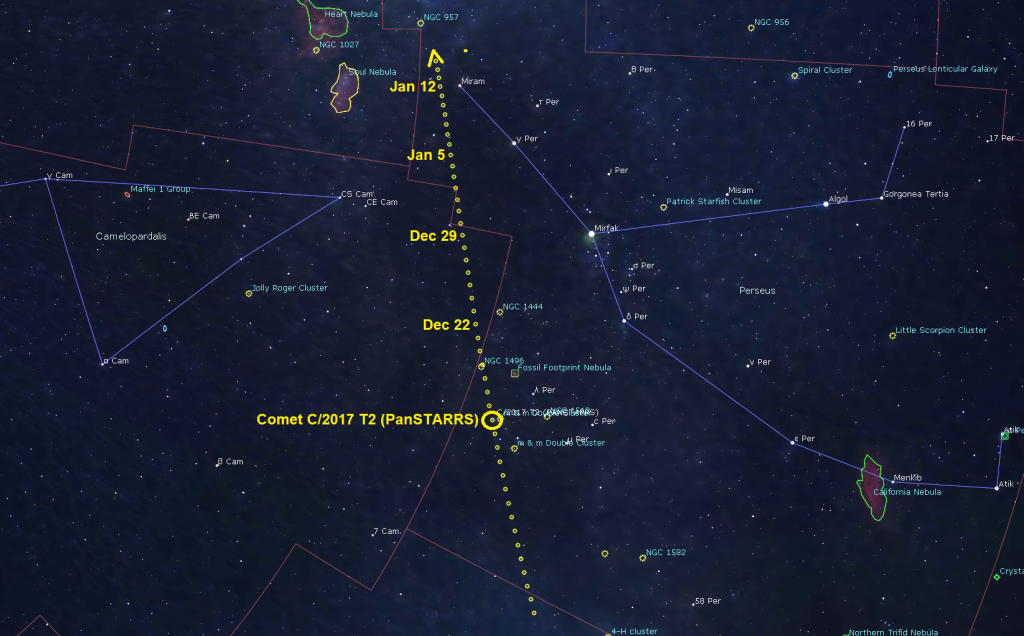
The comet is about halfway up the northeastern sky after dusk – and higher in mid-evening as the Earth’s rotation carries the sky east to west. Comets move across the background stars faster than planets wander. This week, the comet will be just inside the southern boundary of Camelopardalis, and positioned 1.5 fist diameters above (to the celestial northwest of) the very bright star Capella. Another medium-bright star named Mirfak is located a palm’s width to the comet’s upper right (or celestial west). Over the next seven nights the comet will shift farther from Capella. (Camelopardalis, which loosely translates from Latin to “camel leopard”, is the constellation of The Giraffe!)
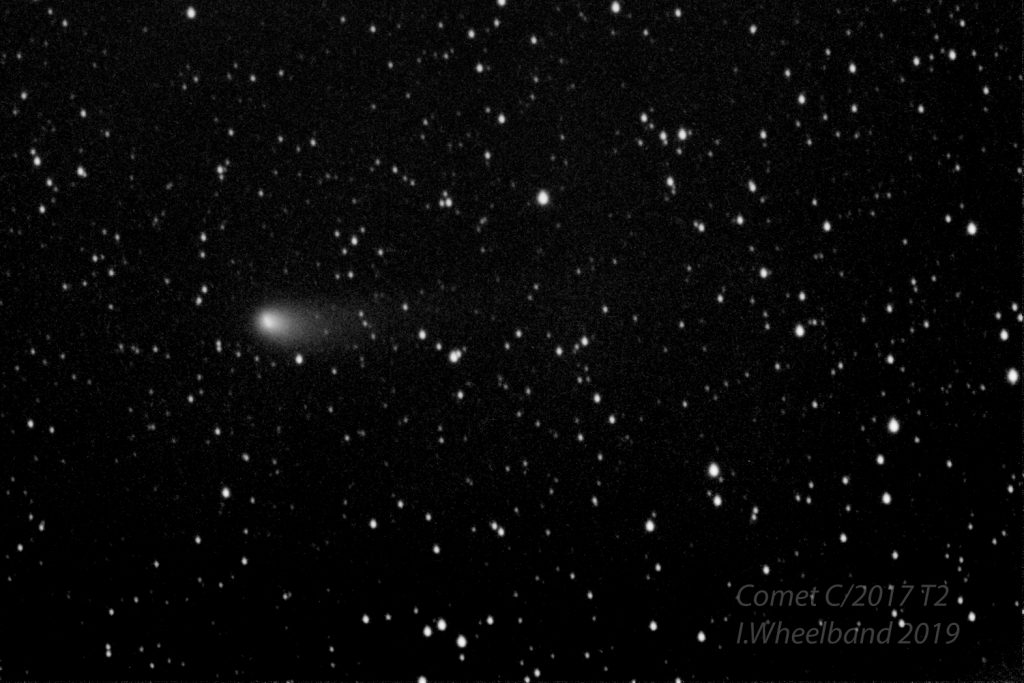
Viewed in binoculars and telescopes, Comet PanSTARRS will appear as a dim, fuzzy patch that might exhibit a faint greenish centre. It’s still too early to see a tail, but the comet is expected to brighten much more in the coming months. Stay tuned for updates!
Meteor Shower News
The annual Ursids Meteor Shower is predicted to peak around 4 pm EST (or 21:00 GMT) this afternoon (Sunday). That timing favours meteor-watchers in Western Europe and Asia because the overhead sky there will be plowing directly into the densest part of the debris cloud that produces the meteors. In North America, we expect to see lower numbers of Ursids before dawn on Sunday and then again on Sunday night (and into Monday). The shower’s radiant is above the Little Dipper in Ursa Minor (the Little Bear), near Polaris, but the meteors can appear anywhere.
To see the most meteors, find a wide-open, dark location, preferably away from light polluted skies, and just look up with your unaided eyes. Binoculars and telescopes are not useful for meteors – their field of view are too narrow. Don’t watch the radiant because any meteors near there will be exhibit short streaks. Try not to look at your phone’s bright screen – it’ll ruin your night vision. And keep your eyes heavenward, even while you are chatting with companions. Happy hunting!
Public Astro-Themed Events
With the Holidays fast approaching, organizations have suspended their public events until January.
This Winter spend a Sunday afternoon in the other dome at the David Dunlap Observatory! On Sunday afternoon, January 12, from noon to 4 pm, join me in my Starlab Digital Planetarium for an interactive journey through the Universe at DDO. We’ll tour the night sky and see close-up views of galaxies, nebulas, and star clusters, view our Solar System’s planets and alien exo-planets, land on the moon, Mars – and the Sun, travel home to Earth from the edge of the Universe, hear indigenous starlore, and watch immersive fulldome movies! Ask me your burning questions, and see the answers in a planetarium setting – or sit back and soak it all in. Sessions run continuously between noon and 2 pm, and repeat from 2 to 4 pm. Ticket-holders may arrive any time during the program. The program is suitable for ages 3 and older, and the Starlab planetarium is wheelchair accessible. For tickets, please use this link.
Keep looking up, and enjoy the sky when you do. I love questions and requests – so, send me some!